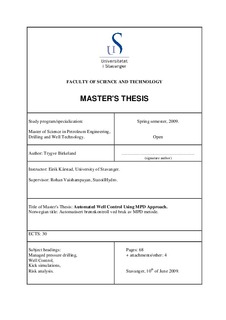| dc.description.abstract | The easy oil and gas is gone. Newly discovered fields follow the trend of being smaller and harder to
reach, moving to increasingly remote locations with high temperatures. The huge fields of the past are
maturing and depleting, which can lead to a narrower window between pore pressure and fracture
pressure. Combining this with the recent decline in oil prices, the demand for lower drilling costs and
more efficient drilling becomes evident. Managed Pressure Drilling (MPD) offers a solution to this by
balancing the downhole pressure and reducing Non-Productive Time (NPT) while drilling. The last
couple of years have seen a steady rise in application of this technology.
Although similar to Underbalanced Drilling (UBD) in terms of equipment used, MPD does not
welcome influxes to surface while drilling. It is, however, better equipped to deal with any resulting
influx than a conventional drilling operation. A literary review of the various methods and applications
of the technology is presented, along with the equipment needed and the drilling problems MPD seeks
to negate. The main focus is on the Constant Bottomhole Pressure (CBHP) variation of MPD as this is
planned for use on Kristin, an HPHT field in the Norwegian Sea. If successful, this would be the
world’s first application of MPD on a floating drilling vessel in harsh conditions.
Special emphasis is placed on well control, as well as detection and subsequent circulation of kicks.
Kick simulations were performed in Drillbench© for a well drilled conventionally on Kristin in 2008,
referred to as Well A. The simulation setup was based on 160 bar depletion in the Ile formation, while
the Garn formation above was undepleted. The simulations showed that kicks from Garn of 1.6 m3 and
above would fracture the Ile formation for low mud weights. Based on this, it is not recommended to
drill conventionally on similar depleted wells, due to the narrow window between pore and fracture
pressure. MPD is recommended as an alternative as it is better at detecting and circulating kicks. To be
able to compare MPD and conventional mode and conclude which one is best suited for Well A,
similar kick simulations are recommended for MPD mode. Such simulations were outside the scope of
this thesis.
A comparative risk analysis is made between the conventional method of circulating kicks and the
MPD method planned for use on Kristin. The objective is to find out if MPD offers any benefits in
terms of added safety or efficiency while dealing with influxes. Based on the analysis, MPD can safely
be used when the conventional system acts as a backup. If encountering a large kick in MPD mode,
one can always shut-in and circulate it out via the conventional system. However, such a large kick is
improbable, as the MPD system is specifically designed to detect kicks early and avoid development
of large kicks. The conventional system relies on human interaction, which represents a significant
safety concern. The MPD system is almost entirely automatic, eliminating much of the risks associated
with human delay and error. Since the MPD system can drill ahead during a small kick without the
need for shutting in the well, it saves considerable rig time compared to the conventional system. | en |
